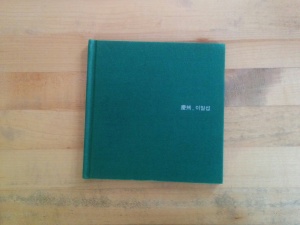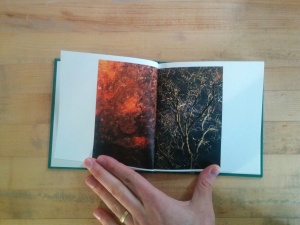I began writing this review with the earth, several miles below me and lost in streams of white clouds. White noise from the jet’s engines enveloped the cabin in a haze of near silence. Yi Ilsup’s Images of Being seemed a good companion for a flight. After several days of consumer delight (Christmas gifts and post-holiday bargain hunting), the white space of the flight presented an optimal opportunity to concentrate and reflect upon Yi’s meditative paired photographs.
As I looked through the book and tried to formulate my thoughts on it, it dawned on me that I was missing a great deal of meaning without a better understanding of Korean Buddhism (let alone Buddhism generally). Even a close reading of the photographs will come up lacking without some contextual information. (There is no text in the book except the title page and colophon.) While I’m hesitant to rely on Wikipedia, I turned my attention to its knowledge base to find the ground from which I could gain better perspective on Yi’s photographs.
A general historical sketch of Korean Buddhism from Wikipedia:
When Buddhism was originally introduced to Korea from Former Qin in 372,[6] or about 800 years after the death of the historical Buddha, Shamanism was the indigenous religion. As it was not seen to conflict with the rites of nature worship, Buddhism was allowed to blend in with Shamanism. Thus, the mountains that were believed to be the residence of spirits in pre-Buddhist times became the sites of Buddhist temples.
Korean Shamanism held three spirits in especially high regard: Sanshin (the Mountain Spirit), Toksong (the Recluse) and Chilsong (the Spirit of the Seven Stars, the Big Dipper). Korean Buddhism accepted and absorbed these three spirits and, even today, special shrines are set aside for them in many temples. The Mountain Spirit receives particular recognition in an attempt to appease the local mountain spirits, on whose land the temple stands. This blend of Buddhism and Shamanism became known as Korean Buddhism, although the fundamental teachings of the Buddha remained.
Returning to Yi’s book: The opening pair of photographs is a tight image of a relief sculpture of Buddha bathed in golden light across from an image of a leaf less tree with it’s branches limned by a cool white light against a dark sky. While the Buddha sculpture clearly makes clear that Buddhist thought is the book’s locus, I wasn’t sure what to make of the tree. It seemed lifeless except for a handful of fruit hanging from an upper branch. Was this a representation of death (and rebirth?) to be meditated upon? Drawing on my brief foray into Wikipedia, I see in it now the suggestion of Korean Shamanism–the Sandalwood King maybe? This opening pair suggests a conceptual framework that is not generally Buddhist but specifically Korean Buddhist in nature.
The photographs that follow mix still life, documentary and landscape photographs. A small fire burns; light rakes across the rough stone of Buddha reliefs; lay people pray; a deep yellow sun burns through a red haze; flower petals and paper lantern panes lay shriveled on the ground. Formal religious objects and practices are set against natural scenes and natural processes. The passing of time and intimations of mortality run throughout. A distinct beauty haunts the photographs.
I cannot say that Yi’s photographs have brought me to enlightenment. That is unfair; for my part, I certainly haven’t done any work towards such a goal. His book has certainly opened my eyes to knowledge I do not possess–and would need years to acquire an understanding of. For those with a working or masterful understanding of the book’s religious underpinnings I imagine that it would be a mindful reference. For those, like me, without such understanding, it offers beauty for beauty’s sake from which one can intuit Yi’s underlying themes or a point of departure for further, deeper inquiry.
Images on Being
Yi Ilsup
2009
As an object, Images on Being is a understated, modest delight. It is beautifully printed. The original print tacked in at the back is a nice touch. It is mildly annoying that the images do get somewhat lost in the gutter.


